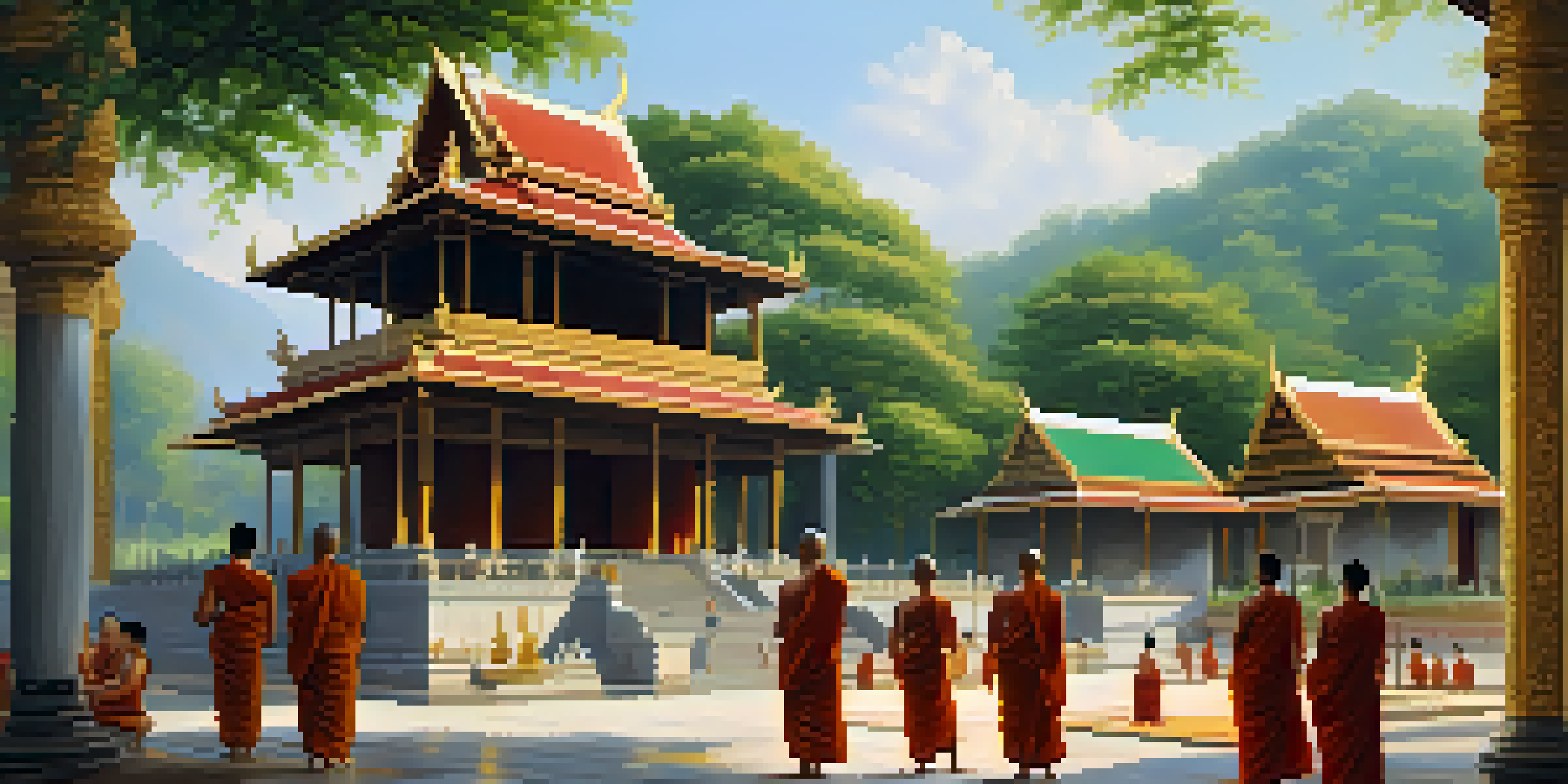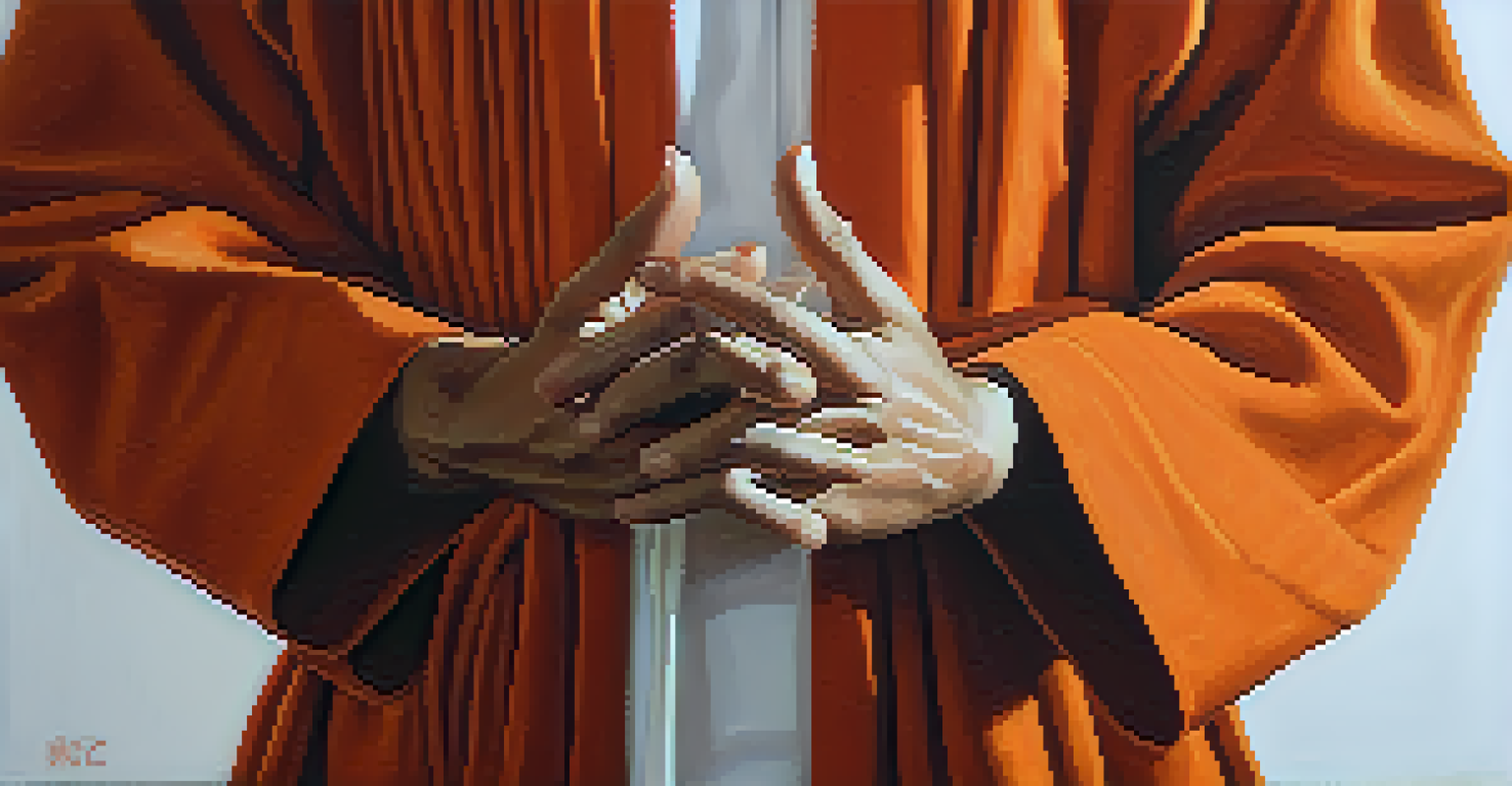Buddhism in Thailand: Understanding Religious Etiquette

Introduction to Buddhism's Role in Thai Culture
Buddhism is deeply woven into the fabric of Thai culture, influencing daily life and social norms. With around 95% of Thais identifying as Buddhist, it shapes everything from festivals to family values. Understanding this connection is vital for anyone looking to engage respectfully with the local culture.
Buddhism teaches that we are all interconnected, and the well-being of each person contributes to the well-being of the whole community.
The Thai version of Buddhism, known as Theravada, emphasizes personal meditation and ethical living. This branch is distinct from Mahayana Buddhism, prevalent in countries like China and Japan, which focuses more on communal practices. The differences highlight the diversity within Buddhist practices around the world.
In Thailand, temples, or 'wats', are not just places of worship but also community centers. They serve as gathering spots for festivals, educational activities, and social services, reflecting the integral role of Buddhism in uniting communities. This interconnectedness underscores why understanding Buddhist etiquette matters.
Common Buddhist Practices in Thailand
Daily life in Thailand often incorporates Buddhist practices, such as merit-making and meditation. Many Thais participate in rituals like giving alms to monks, which is seen as a way to gain good karma. This act not only supports the monastic community but also fosters a sense of gratitude and humility among participants.

Meditation is another key practice, with many Thais dedicating time to reflect and find inner peace. Various forms of meditation, including mindfulness and loving-kindness, are popular and often taught in temples. These practices are not only spiritual but also contribute to the overall well-being of individuals.
Buddhism Shapes Thai Daily Life
With 95% of Thais practicing Buddhism, it influences everything from social norms to community gatherings.
Festivals like Visakha Bucha, which celebrates the Buddha's birth, enlightenment, and death, showcase the importance of these practices. During such events, you’ll see locals engaging in candlelight processions and chanting, emphasizing community and shared beliefs. Observing these rituals can deepen your understanding of Thai spirituality.
General Etiquette When Visiting Temples
When visiting a temple in Thailand, dressing appropriately is a must. This means wearing modest clothing that covers your shoulders and knees, as a sign of respect. Flip-flops are often acceptable, but it's best to remove shoes before entering temple buildings, as cleanliness is highly valued.
Respect is one of the greatest expressions of love.
While inside the temple, maintaining a respectful demeanor is crucial. Speaking softly and refraining from loud laughter or disruptive behavior shows consideration for those who are there to pray or meditate. It's also important to follow any posted signs or guidelines, which are in place to maintain the sanctity of the space.
Photography can also be a sensitive issue in temples. While capturing the beauty of the architecture is tempting, it’s best to ask for permission before taking photos of monks or worshippers. This simple act of courtesy goes a long way in fostering mutual respect between visitors and locals.
Respecting Monks and Their Role
Monks hold a revered position in Thai society, often viewed as spiritual leaders and role models. When interacting with them, it’s important to show deep respect, which includes using polite language and gestures. For instance, a slight bow or the traditional 'wai' gesture, where you place your palms together, is a respectful greeting.
It’s customary for women to avoid direct physical contact with monks, such as handing them items directly. Instead, items should be placed on a nearby surface, allowing the monk to pick them up. This practice stems from the belief in maintaining purity and respect within the spiritual hierarchy.
Temple Etiquette is Essential
Dressing modestly and behaving respectfully are crucial when visiting temples to honor Thai customs.
Listening attentively when monks speak is also a sign of respect. Many monks share teachings and insights that can be enlightening, so engaging in their wisdom can lead to meaningful conversations. Remember, their role extends beyond religious duties; they often play a vital part in community support and education.
Understanding the Importance of Wai
The 'wai' is more than just a greeting; it's a fundamental aspect of Thai culture that signifies respect and humility. This gesture involves placing your palms together in a prayer-like position and bowing slightly. It’s commonly used to greet elders, monks, and anyone in a position of respect.
The height of your hands in the wai indicates the level of respect you are showing. For instance, a higher position is used for monks and elders, while a lower position is appropriate for peers. Understanding this nuanced gesture can enhance your interactions and show your appreciation for Thai customs.
It's also important to note that the wai is typically returned. If someone greets you with a wai, it’s courteous to respond in kind. This mutual exchange fosters goodwill and connects you to the local culture, allowing for deeper, more meaningful interactions.
Special Occasions and Their Etiquette
Thai Buddhist festivals, such as Songkran (the Water Festival) and Loy Krathong (the Festival of Lights), come with their own set of etiquettes. During Songkran, for instance, it's common to splash water as a symbol of cleansing and renewal. However, it’s essential to participate respectfully, keeping in mind that this is also a time for spiritual reflection.
During Loy Krathong, people release floating lanterns on rivers, symbolizing letting go of past grievances. Engaging in this activity is not just about watching the lanterns; it's about understanding their significance and joining in the spirit of forgiveness and renewal. Showing respect for the rituals involved enhances your experience.
Wai Gesture Signifies Respect
The 'wai' is a fundamental gesture in Thai culture that conveys respect, particularly towards monks and elders.
Attending these festivals can be a fantastic way to immerse yourself in Thai culture. However, it's best to observe local customs and participate mindfully, ensuring that your actions align with the sentiments of the occasion. This approach not only enriches your experience but also shows appreciation for the local traditions.
Final Thoughts on Practicing Respect
Navigating the rich tapestry of Buddhism in Thailand requires a blend of openness and respect. By familiarizing yourself with the etiquette surrounding Buddhist practices, you can foster more meaningful connections with the local community. This understanding can transform your experience from a mere visit to a profound journey.
Remember, respect is a two-way street. While you may be learning about Thai culture, locals will appreciate your efforts to honor their traditions. This mutual respect creates a welcoming environment that encourages deeper cultural exchanges.

In conclusion, embracing the etiquette of Buddhism in Thailand not only enriches your travels but also honors the heart of Thai culture. So, as you explore this beautiful country, carry these insights with you, and let them guide your interactions with the people and their traditions.